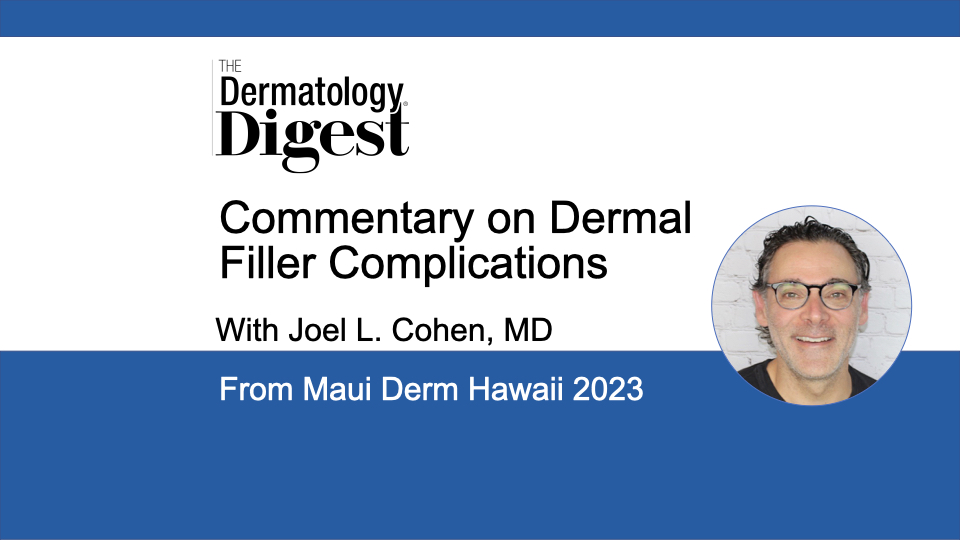Dr. Joel L. Cohen discusses dermal filler-related complications, including strategies for prevention and management.
Joel L. Cohen, MD, Director, AboutSkin Dermatology and DermSurgery, Denver, Colorado
“At Maui Derm, I really did an overview of the different types of filler-related issues that we can potentially see,” said Joel Cohen, MD, who presented “Dermal Filler Complications: How to Avoid Them and How to Manage Them When They Occur.”
“Obviously bruising is very common and if we can get patients to discontinue nonessential supplements, vitamins, even ibuprofen and other nonsteroidal anti-inflammatory derivatives ahead of time that can be helpful.”
Avoiding alcohol for several days prior to injection can also be helpful, said Dr. Cohen.
“But obviously we can’t discontinue things that are ‘therapeutic.’ So for anybody who has a history of a heart attack, stroke, blood clot, or atrial fibrillation, then I don’t discontinue any of those other medications specifically before fillers nor do I do it before Mohs surgery.”
This approach is supported by the literature, including articles from Drs. Leonard Goldberg, Clark Otley, and Dick Bennett, according to Dr. Cohen.
“When people do have a lot of apparent ooziness, there are things that we can do from a pressure standpoint initially and then have patients ice subsequently. But having patients follow up a day or two later for consideration of pulsed dye laser or some type of IPL or BBL device can be helpful to minimize the bruise.”
According to Dr. Cohen, using the pulsed dye laser is most effective when the bruise is purple before any yellows begin to appear.
“For pulsed dye laser I use a setting of 7 joules, 6 milliseconds with a 10-millimeter spot when the bruise is still purple and I try to make sure that I don’t stack pulses [and] that I ice in between the pulses because it is a pretty significant chromophore.”
Superficially placed dermal filler is another common complication, said Dr. Cohen.
“For superficial hyaluronic acid (HA) filler, a lot of times you can just take your thumb and massage this area out with some lotion.”
Be sure to have access to hyaluronidase enzyme (Hylenex or Vitrase) for more serious HA-based dermal filler complications, said Dr. Cohen.
“I think it’s important that we have these things on hand not to treat somebody who may have superficial placement but really [to] be prepared for somebody who may have some evidence of vascular struggle and impending necrosis.”
Notably, some patients have delayed reactions to fillers, he said.
“In some cases, this may be a biofilm with some type of underlying, delayed infection. So somebody who has something placed, let’s say, infraorbitally and everything is fine, and then they have an upper respiratory infection or they have a sinus infection, or they have their teeth cleaned, and we [see] swelling and erythema in these areas… oftentimes we’ll put them on an antibiotic that also has an anti-inflammatory effect.”
Some of these delayed reactions may also just be inflammatory without infectious tissue, said Dr. Cohen.
“In some cases, we see these as certain bumps in an area, such as under the eyes or the lip, and those characteristic bumps and little nodules are very different than that sort of biofilm type of redness and swelling.”
For delayed inflammatory reactions not thought to be infectious, using a combination injection of intralesional steroid plus 5-fluorouracil very focally can help to minimize the reaction, he said.
“In terms of impending necrosis, I think that, typically, the filler is directly in a blood vessel. That becomes the concern. There is an immediate blanch and later the patients have a purple or reticulated violaceous pattern along that segment of the vessel.”
According to Dr. Cohen, although it may be theoretically possible to have a blood vessel compressed externally from excess product placed around a vessel, it’s unlikely.
“Most of the time someone has transiently gotten into a vessel. So I think some people are really describing some microvasculature alteration rather than some sort of compression issue.”
Regardless, in the event of this serious complication of impending necrosis, it is best to flood the area with hyaluronidase, said Dr. Cohen.
“We know from some work from Claudio DeLorenzi that hyaluronidase enzyme can actually cross the vessel wall. He showed that in Dermatologic Surgery1 a number of years ago looking at a cadaver facial artery and demonstrated that hyaluronidase does cross that vessel wall.”
Taking it one step further, some researchers are using duplex ultrasound guidance to show exactly where the area of impending necrosis lacks flow to guide the hyaluronidase needle placement, he said.
“And then on the same level as getting into a vessel and causing necrosis, there have been reports of blindness. Many of these reports have been really in the central face of the glabella or the proximal nasal dorsum or along the nasal dorsum in general. The dorsal nasal artery or the supratrochlear artery gets inadvertently injected, unfortunately, and then there’s retrograde flow to the ophthalmic artery, which then flows to the central retinal artery.”
In the event of accidental intravascular injection, it is probably your best bet is to perform a retrobulbar hyaluronidase injection, according to Dr. Cohen who referred to the Barbarino et al. article on eye emergencies.2
“I think it’s important that when we do take cadaver courses, and we learn injection anatomy, that people familiarize themselves with how to do a retrobulbar injection and how to put the needle along the orbital floor, starting lateral, moving medial, and instilling hyaluronidase in that injection to try to improve very quickly somebody who may have visual compromise after an injection of hyaluronic acid.”
References:
- DeLorenzi C. Transarterial degradation of hyaluronic acid filler by hyaluronidase. Dermatol Surg. 2014 Aug;40(8):832-41. doi: 10.1097/DSS.0000000000000062. PMID: 25022707.
- Barbarino S, Banker T, Fezza J. Standardized approach to treatment of retinal artery occlusion after intraarterial injection of soft tissue fillers: EYE-CODE. J Am Acad Dermatol. 2022 May;86(5):1102-1108. doi: 10.1016/j.jaad.2020.12.047. Epub 2020 Dec 27. PMID: 33378659.


